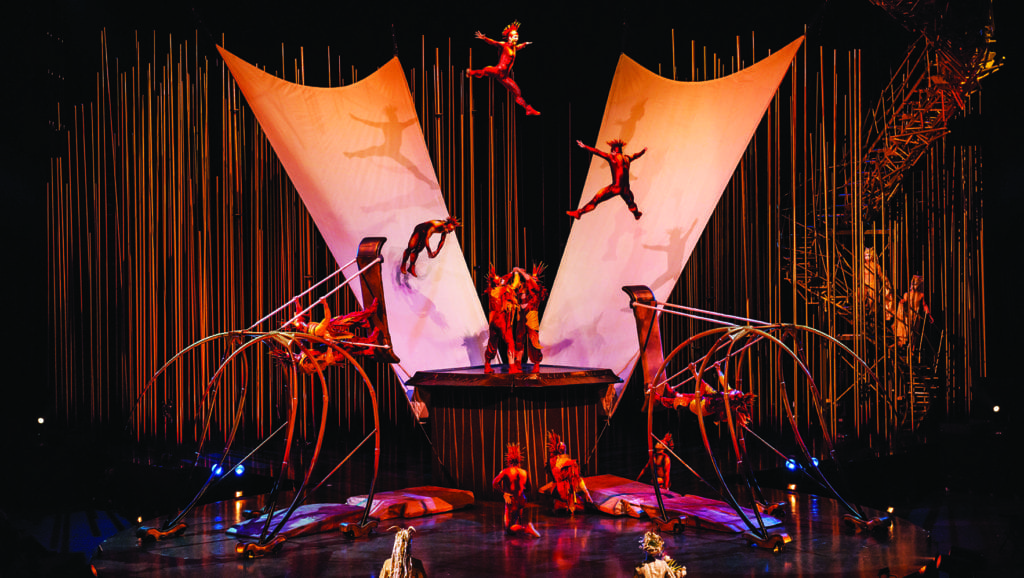Cirque du Soleil brings ‘Varekai’ to Boston
Circus troupe performed six shows at Agganis Arena

Cirque du Soleil first brought its pioneering vein of circus arts enchantment from Québec to Boston in 1993. Under a big top, its international cast and animal-free circus offered astonishing aerial stunts, acrobatics and clowns, and a delicate, spellbinding beauty that held audiences in thrall.
Since then, Cirque du Soleil, which started in the ‘80s as a band of 20 stilt-walking and juggling street performers, has grown into a global entertainment juggernaut reaching more than 40 countries. Its repertoire of shows suits varied settings—from big tops and resident venues (five in Las Vegas alone) to places such as the Agganis Arena at Boston University, where last Thursday through Sunday it performed six shows.
The troupe restaged a 15-year-old production entitled “Varekai, Tales of the Forest” that is engineered to suit such a space, where seating for 7,200 accommodates a crowd almost threefold larger than an audience for big top shows. But bigger, as they say, is not always better.
Instead of the nonstop wonders of smaller-scale shows, in this production, running about two hours with a 20-minute intermission, the pleasures peak in particular episodes, wherein the superb performers can engage the audience despite a barrage of high wattage sound and lights.
“Varekai” has a story, but it is no more than a loose framework for the show: A young man, Icarus, in a white body suit and great white wings, descends from the ceiling onto a set that suggests Middle Earth, peopled by surreal, semi-human creatures that slither, hop and swing across the stage using mats, aerial devices and a ceiling-high web of trees.
Like most Cirque du Soleil shows, “Varekai” is international in its circus art traditions, music and cast. With a cast of 50 from 19 countries, at its core, the show is a review. Icarus encounters a world of varied creatures, and the production sags or peaks with the intimacy and energy of each encounter. Meanwhile, an off-stage band of seven musicians perform the score, an eclectic mix of world music.
Dialect and aerial delight
Instead of an actual script, the cast often speaks in gibberish when they have something to say. The technique has its roots in the medieval practice known as “Grammelot,” used by traveling satirical troupes in Europe. Communicating by mime and a made-up language that mimicked a local dialect, they could insult corrupt politicians and clergy but evade censors. The technique was picked up by 16th-century Commedia dell’arte troupes and revived in our era by Nobel-winning Italian actor, playwright, director and set designer Dario Fo.
High points in Icarus’s wanderings include a traditional martial arts dance by a trio of acrobats from the Republic of Georgia, an aerial duet by a pair of black-wigged gymnasts, a synchronized tumbling act by a five-member troupe from Japan, and Arisa Tanaka’s rotating sticks, which whirl like shooting sparks.
The show’s clown couple also injects an enlivening human touch. Steven Bishop plays a debonair but hapless magician whose giddy partner (Emily Carragher), wearing a blond wig and short bouffant dress, scoops up a male audience member and puts him through a slapstick disappearing act. Even better, Bishop returns as a crooner running around to stay in an ever-moving spotlight, even scaling the arena’s steep stairs, all the while mouthing a recording of a tender French ballad.
Among the creatures Icarus meets is a girl who becomes his love interest, an encounter that precipitates the show’s two sublime solos. As the girl’s mother, Kerren Mckeeman gives her blessing on their union in an astonishing trapeze performance, at one point supporting her entire curved body by the back of her neck.
Before the finale, a sort of wedding celebration in which an ensemble of 12 acrobats hurl themselves across the stage between two trampolines and pair in midair,
Shenea Booth, as the bride, performs a solo. Balancing herself on a cane upside down as she shifts her weight and turns her legs from side to side, she fuses dance and acrobatics to perform a wordless aria of love.




![Banner [Virtual] Art Gallery](https://baystatebanner.com/wp-content/uploads/2024/04/NJ-H_1-713x848.jpg)

